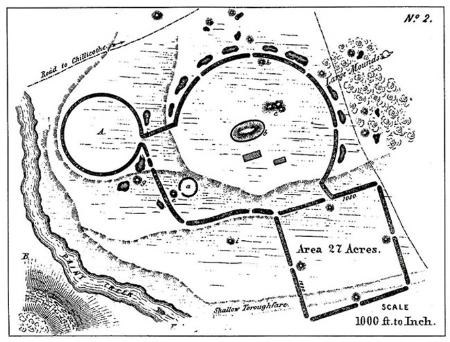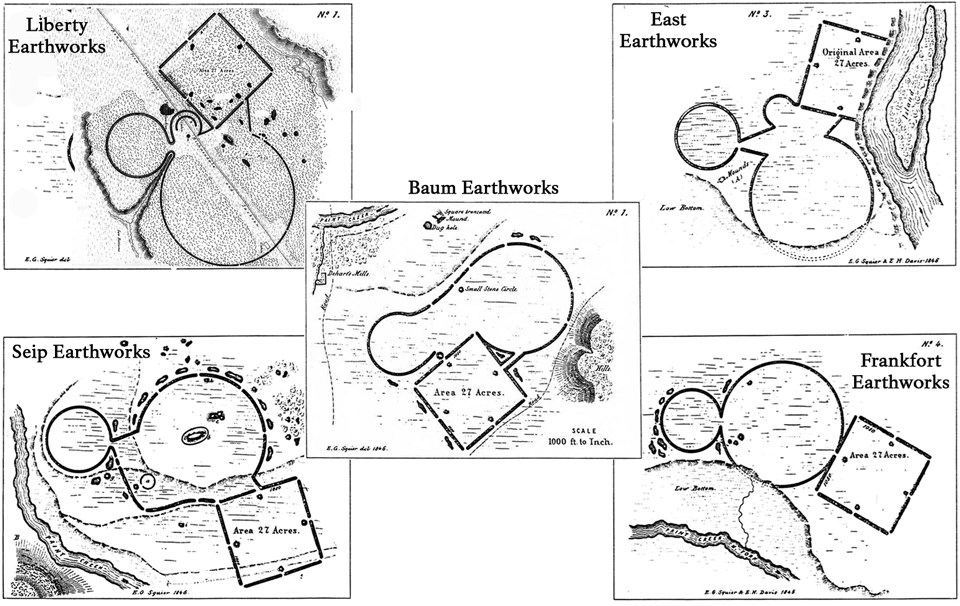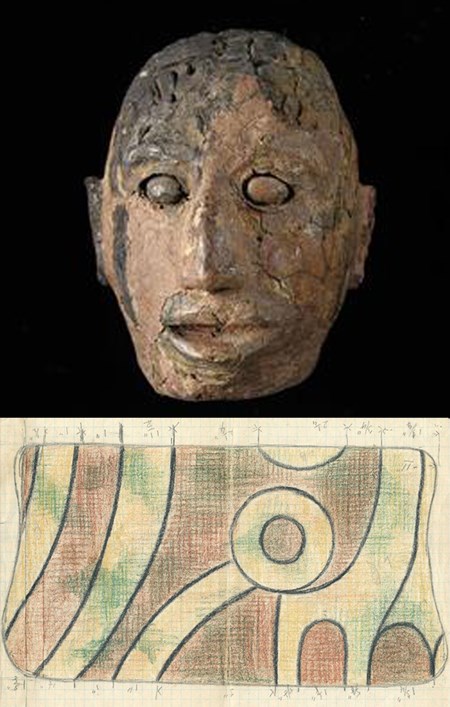
Squier & Davis, c.1848 Introduction

Squier and Davis, c.1848 A Mysterious CultureBetween 1 - 400 A.D., southern Ohio witnessed an extraordinary blossoming of cultural development. Even though they did not live in villages or practice large scale agriculture, Indigenous people of the Hopewell Culture made amazing advances in the fields of mathematics, engineering, art, trade and astronomy. However, why they built so many enormous ceremonial complexes in this area remains a mystery. There is no evidence that people lived within these earthworks. Rather, these huge architectural wonders appear to have been designed for large ritual gatherings. The timing of these special ceremonies was perhaps determined by astronomical cycles. Pilgrimages may have been made to these sacred enclosures by celebrants from far away. Remarkable DesignIt is clear that complexes like the Seip Earthworks were not the result of a haphazard heaping of earth. The geometric shapes are precise in their symmetry. In fact, the design and dimensions of Seip Earthworks are so similar to four other complexes around the Chillicothe area that they all must have been the result of engineering plans produced by the same group of people. Baum, Frankfort, Works East, Liberty and Seip Earthworks are all comprised of a small circle, a large circle and a square. When early American archeologists Ephraim Squier and Edwin Davis mapped and measured these five earthwork complexes in the 1840’s, each square was the same size: 1,080 feet to a side, 27 acres. This impressive feat suggests that the Hopewell people had a common unit of measure 2,000 years ago. Also, the dimensions of the three shapes indicate that the Hopewell even understood mathematical relationships between circles and squares. 
Courtesy Ohio History Connection The Central MoundSometimes referred to as Seip Mound, this enormous reconstructed mound in the center of Seip Earthwork’s great circle enclosure is the third largest burial mound the Hopewell are known to have built: 240’ by 160’ by 30‘ high. It covered the floors, fire pits and burials of two very large connected buildings with a small building between them. Among the beautiful artifacts found here by archeologists of the Ohio Historical Society in 1925 is the famous clay Seip Head (right), now on display in the Ohio History Center in Columbus, Ohio. Also, between stacks of copper breast plates, some of the few intact samples of Hopewell cloth (right) were discovered, preserved by the cooper salts that formed over the breastplates. Woven of milkweed fibers, the clothes were dyed to create patterns of circles and curves reminiscent of Hopewell earthworks. Respecting Our National HeritageArcheological resources are nonrenewable and irreplaceable. Archeologists in the 19th and 20th centuries excavated many burials to learn about the Hopewell Culture because the mound builders left no written language or recorded histories and no extant tribes were the clear descendants of these people who lived so long ago. Attitudes about archeology and indigenous cultures are changing and modern legislation preserves and protects our national heritage. Archeologists no longer excavate Native American burials in these earthworks out of respect for the cultural traditions of indigenous people. Today, archeological investigations are conducted in consultation with Indian tribes and focus on non-burial areas in an effort to better understand, appreciate and preserve this priceless heritage. Laws now protect archeological sites like Seip Earthworks from unauthorized ground disturbance or artifact collecting. Please respect our national heritage by staying on trails and off of earthworks. Seip Earthworks TodayThe Central Mound and much of the center of the Seip complex were originally owned by the Ohio Historical Society, which had preserved parts of this site since its excavation and partial reconstruction in the 1920’s. In the 1990’s, the National Park Service began the process of purchasing most of the rest of the complex and adding it to Hopewell Culture National Historical Park. The Ohio History Connection’s portion was transferred to the National Park Service in 2014. Visiting the SiteA reconstructed mound and a portion of reconstructed wall are visible, and a portion of original wall is visible near Dill Road. Parking is only accessible at the front of the site, off of U.S. Route 50. There are no longer any restroom facilities at this site. The covered picnic shelter is available on a first-come, first-served basis only. Interpretive signs are placed throughout the earthwork site, along the trails. The site is open every day during daylight hours. See map below for layout of trail and parking lot access. Site Map & Trail Map
NPS / Tom Engberg & Bruce Lombardo Earthwork outline in map: United States of America (2022). “Hopewell Ceremonial Earthworks, Ohio, United States of America. Nomination to the World Heritage List by the United States of America." Hopewell Ceremonial Earthworks - Documents - UNESCO World Heritage Centre. A Historic Re-dedicationSince the early 20th century, much of the Seip Earthworks unit was owned by the Ohio History Connection (OHC) (formerly known as the The Ohio State Archaeological and Historical Society and the Ohio Historical Society). Between 1992 and 2014, The National Park Service had partnered with the Ohio History Connection in co-owning and co-managing the Seip Earthworks site. After a decades worth of arranging and planning, the deed of ownership to Seip Earthworks was officially transferred from OHC to the National Park Service on September 3, 2014. Even though the government-owned majority of Seip Earthworks is now solely under the possession and management of Hopewell Culture NHP, we will continue our proud partnership with OHC in meaningful and creative ways to preserve and protect the remnants of the Hopewell Culture. |
Last updated: July 10, 2024
